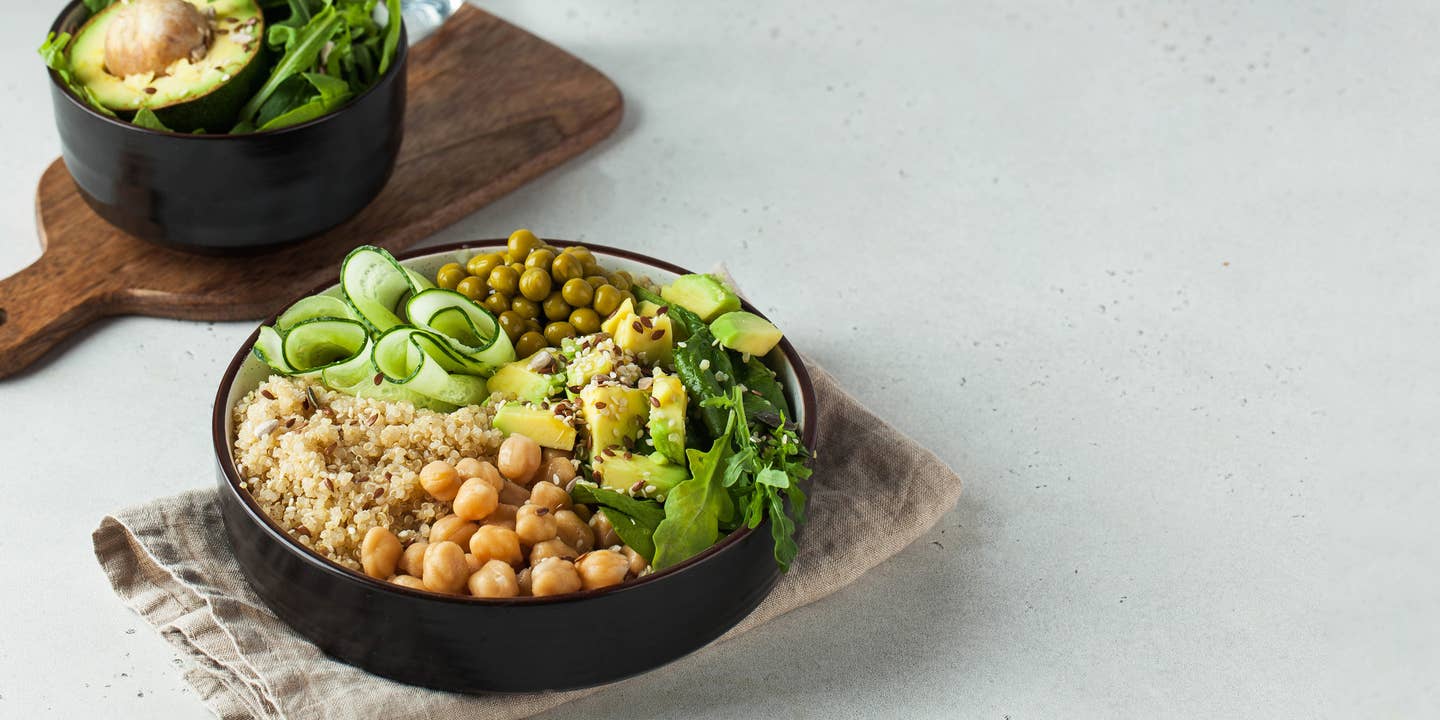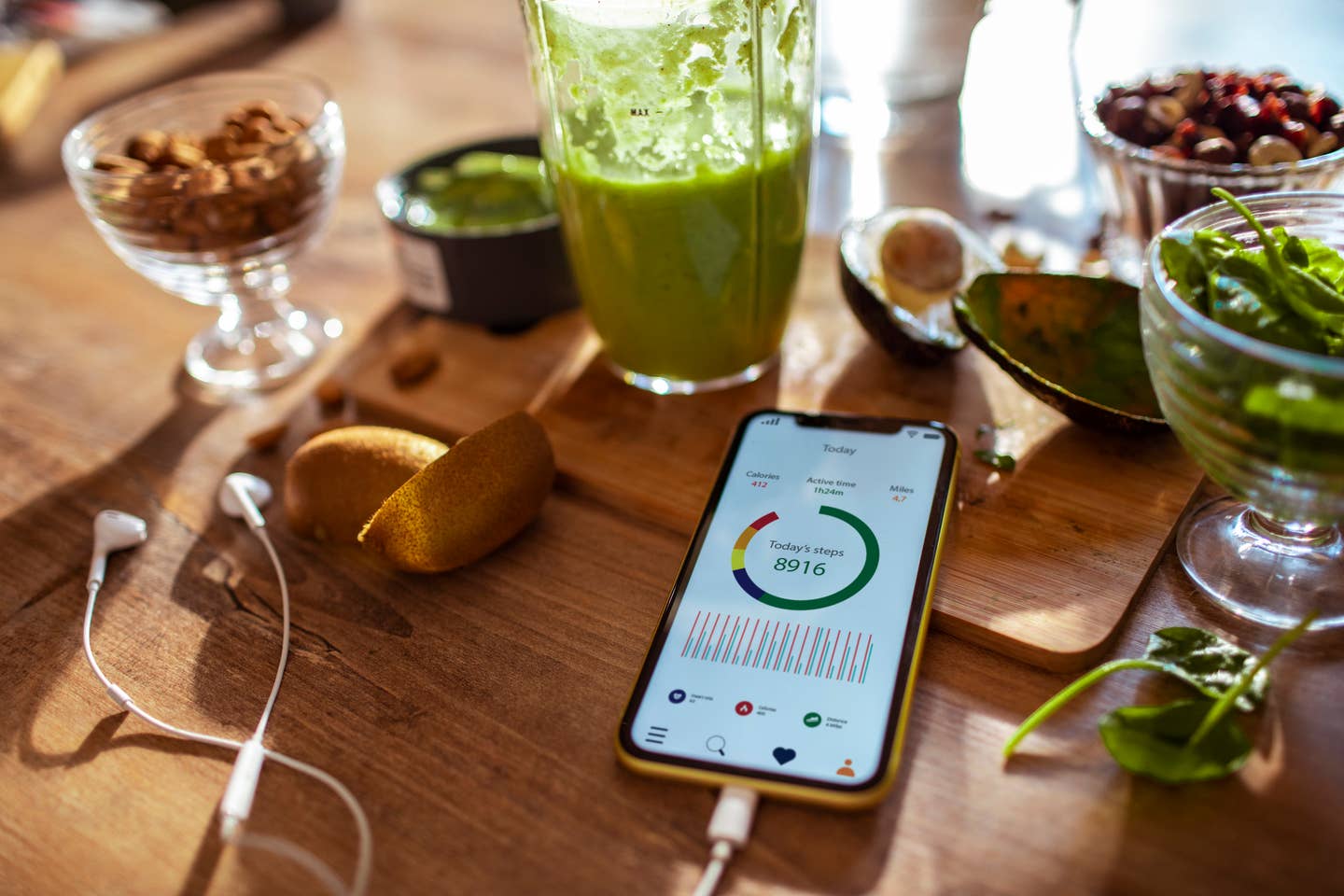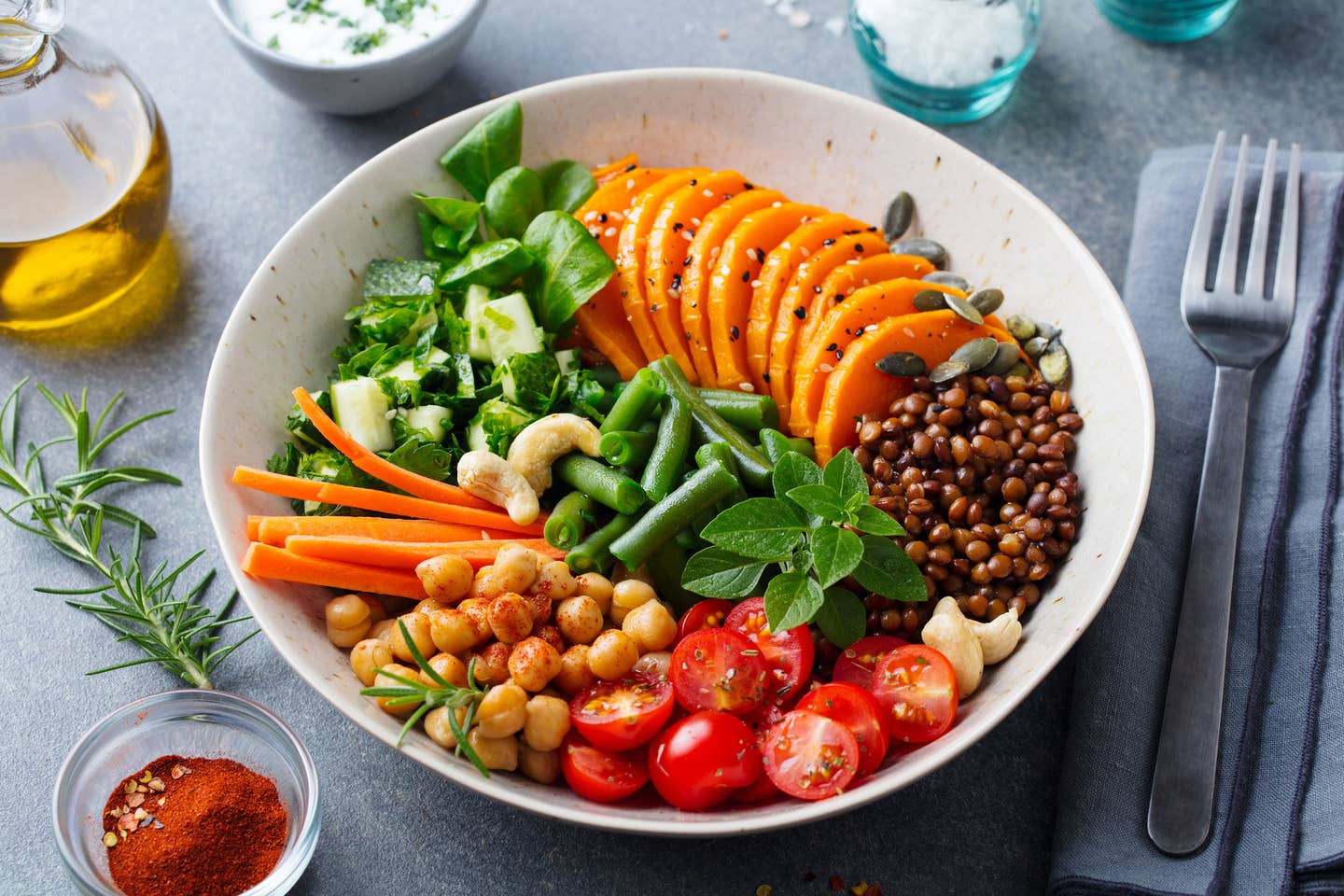
3 Easy Food Timing Tricks to Control Blood Sugar and Promote Weight Loss
If you know anything about how your body digests food and turns it into energy – or stores it as belly fat – then you also understand the relationship between blood sugar spikes, insulin surges, and weight gain or conversely how, by keeping blood sugar steady and in check, it helps your ability to burn fat and lose weight more easily.
Essentially, if you eat more added sugar or simple carbs or indeed any excess calories than your body needs or can use in the following hours, these extra calories flood the system, spiking blood sugar and prompting the release of insulin, the hormone that tells the body to use it or store it, as fat. How to keep blood sugar in check? Studies now tell us it may be as easy as timing what you eat, when you eat it, and using a technique called food combining.
Science tells us that three easy strategies can keep blood sugar low and prevent those glucose spikes that lead to unwanted weight gain. If you are trying to lose weight or just maintain a healthy weight, or you want all-day energy without the highs and lows of blood sugar spikes such as a few hours after eating, try any or all of these three things:
3 Tricks to Keep Blood Sugar from Spiking
1. Fiber before food.
A green salad or crudites such as celery, carrots, endive or snap peas or a few florets of raw broccoli can act as a brake on how fast the food you eat next gets absorbed, keeping blood sugar lower than if you had not eaten the fiber-rich side dish first. Have the dressing, since a little fat also goes a long way to keep you full and prevent you from feeling hungry soon after.
2. Dinner at 8 is too late.
Studies have shown that the earlier you eat your last meal of the day, and quit eating – tell yourself "the kitchen closes at 8" – the lower your blood sugar will be, not just after dinner but for the next 24 hours. In fact, you should pack in more of your daily calories earlier in the day. Make your mid-day meal the one that sustains you, and stop eating early.
3. Carbs need partners.
When you eat carbs, especially simple carbs like bread, pasta, rice, or vegetable starches like potatoes, studies show that to keep blood sugar from spiking it helps to add protein and a little fat. This keeps you fuller for longer. So, cookies and milk are better than cookies alone.
To make it super easy to visualize, the body absorbs simple carbs (like bread and pasta) most easily, and fiber (like salad greens, beans, nuts, and vegetables like broccoli) more slowly because fiber is harder to break down. That means if you pour sugar into the system first, it spikes blood sugar, whereas if you add fiber in the form of a green salad or snap peas and edamame first, it is like putting a Brillo pad in the drain, and what comes next goes down slower.
With dietary fiber in the system, your body has to work harder to absorb the next calories you eat, since soluble and insoluble fiber helps make your gut work harder to break everything down. The slower you absorb calories, the more time your muscles, liver, and other organs and cells have to use it up. Here's how the timing of food and combining of foods works.
Healthy Blood Sugar and Weight Loss
To flatten the spikes in blood sugar and keep your body burning, rather than storing fat, another recent study found that eating a salad with a high-fat, high-carb meal was better than eating the meal alone and skipping the salad.
This research shows that just adding fiber-filled foods to your plate and eating those before your load up on simple carbs, can make a big difference when it comes to weight gain, weight loss, and energy levels.
The slower your calories get absorbed into the bloodstream from the intestines, the more the body has a chance to burn them off rather than create a surge in insulin. The result: You stay fuller longer, have more lasting energy, and never get tired soon after eating, since as blood sugar drops back down, so does your energy level.
Timing of Meals and Blood Sugar
Everyone is obsessed with Intermittent Fasting, which according to one new survey is the most searched diet strategy by Americans right now, and is vastly more popular than the keto diet. By spacing out meals, and not eating between meals, you can not only help your body mobilize fat stores and burn off all that stored energy, but you also offer your immune system a break.
Intermittent fasting, also known in scientific circles as Time-restricted eating (TRE), is the practice of consuming your daily calories within an 8 to 12-hour window - has many health benefits. TRF aids in maintaining healthy body weight, boosts the metabolism, bolsters the immune system, promotes longevity through cellular autophagy, and increases testosterone levels in males.
But intermittent fasting or TRF is not for everyone. For some people, it's hard to skip breakfast and elongate the time between dinner and your first meal the next day to the recommended 14 or more hours. If you're one of those people who functions better when you eat breakfast – and most people get hungry and distracted after 14 or more hours without calories – then the other known approach that works for healthy weight loss is to eat dinner early.
The Earlier You Eat the Better
Logically this is no surprise: Calories that are eaten earlier in the day get burned off. Calories eaten later, closer to bedtime, will likely end up getting stored as fat. Another aspect of meal timing is to eat more calories earlier in the day, not just dinner. A study found that the earlier you eat dinner, the lower your blood sugar is over a total 24-hour period, so the positive effects of an early supper last all night and through the following day.
The study, called "Eating Dinner Early Improves 24-h Blood Glucose Levels and Boosts Lipid Metabolism after Breakfast the Next Day," was published in the journal Nutrients. While it's no surprise that dinner early prevents you from experiencing blood-sugar overload since it logically follows that lying in bed all night, allows the extra calories to go unused. And you can imagine that an early meal allows for an after-dinner walk or other activity that is even more beneficial to your overall fat-burning and healthy metabolism. What was shocking was that the benefits extended into the next day, as measured after your breakfast the following morning.
"It’s good to eat breakfast and the majority of your calories earlier in the day as noted above," says Adam Meyer, a Registered Holistic Nutritionist *RHN) who explains, "but try not to eat within the first few hours of waking as that’s best for the metabolism. 'Breaking your fast' after doing fasted cardio in the morning is a great way to naturally make the metabolism more efficient, prevent blood sugar spikes, and promote weight loss." He adds:
How to Think About Meal Timing for Weight Loss:
- Breakfast like a king, lunch like a prince, and dinner like a beggar. Eating the majority of your calories earlier in the day can help prevent blood sugar spiking and control body weight because your metabolism is faster earlier in the day and therefore more efficient at burning calories.
- Avoid eating two to three hours before going to bed. Eating prior to sleep impairs sleep quality because the digestion process causes your pancreas to release insulin, a metabolic process associated with your circadian rhythm, making it difficult to achieve restful sleep. Also, not eating before bed can help optimize your sleep by allowing your body to focus on repair and recovery instead of digestion.
- Certain foods are more disruptive to sleep than others, namely foods associated with heartburn such as chocolate, spicy foods, citrus, caffeine, and alcohol.
Food Order and Glucose Levels
This work has been well documented and came out of an initial study back in 2015 that showed "food order" matters: Researchers discovered that the order in which people ate protein, vegetables, and carbs had a significant impact on their post-prandial blood sugar. Food order became a well-established practice for dieticians and others helping diabetes patients control their blood sugar for medical reasons.
This finding, published originally in the journal Diabetes Care, had an impact on how clinicians advised diabetic patients and others trying to lose weight. They began to tell overweight patients to focus not only on how much but on when carbohydrates are consumed.
"We're always looking for ways to help people with diabetes lower their blood sugar," said senior author Dr. Louis Aronne, the study's principal investigator. "We rely on medicine, but diet is an important part of this process, too. Unfortunately, we've found that it's difficult to get people to change their eating habits.
"Carbohydrates raise blood sugar, but if you tell someone not to eat them — or to drastically cut back, it's hard for them to comply," explained Dr. Aronne at the time. "This study points to an easier way that patients might lower their blood sugar and insulin levels."
Food Combining and Blood Sugar
By practicing what's now known as "food combining," and paying attention to the order in which you eat your food, and how early you eat, you can keep blood sugar low, include a varied diet of carbs, protein, and fat, and still lose weight, these studies indicate.
Food combining simply requires you to be deliberate and add different food groups to your meal to balance out the rate of absorption. Simply by adding protein and a small amount of fat to your carbs or starches, you can keep blood sugar flatter than carbs alone, which means you burn more calories and store less fat.
Food combining has gotten a lot of attention because it's so easy to do. Add avocado to your protein bread. or eat peanut butter on your slices of apple. If you love a smoothie, add protein-packed oat milk or almond yogurt to the mix. Nuts and legumes are uniquely helpful since they deliver protein, fiber, and carbs all in one powerful nutrient-dense package.
"When you eat carbohydrates by themselves, they spike your blood sugar faster than protein or fat do, because the carbohydrates are designed to be quickly digestible energy," says Amy Goodson, Registered Dietician in the Dallas, Fort-Worth area.
One way to think of blood sugar is that, since your bloodstream can only hold the equivalent of a tablespoon at a time, any extra has to get put somewhere else, like your fat cells, which are essentially the fridge of your body. But if you eat an arugula salad in advance of your carbs, then that arugula with fiber acts as a net, holding back some of the sugar before it can flood the system. The slower the sugar gets added (think of sifting it gradually into a mixing bowl as you bake as opposed to dumping the whole cup full in at once when it spins around out of control) then your body and system can cope with it in a more measured fashion.
Ideal Food Combinations to Keep Blood Sugar Steady
Ideally, your breakfast should be higher in healthy fats and protein combined with low-glycemic-index (GI) carbs, such as rolled oats and blueberries, as they provide more sustainable energy to fuel you through the morning without subsequent blood sugar crashes.
Eating too many carbs, especially high GI ones, will cause your blood sugar to crash soon after breakfast, making you crave more carbs and more likely to cave and eat unhealthy snacks. Also, since your metabolism is more efficient earlier in the day, your body is better able to burn off the additional calories from fats instead of storing them as fat as you would later in the day.
For Breakfast: Rolled oats with peanut butter, walnuts, hemp seeds, pumpkin seeds, blueberries, and a banana. Contains plenty of healthy fats, protein, and some low-GI carbs.
For Lunch: A high-protein meal will help stave off the dreaded ‘afternoon slump’. Protein is highly satiating, so consider having a chickpea salad or lentils and avocado to have sustainable energy throughout the afternoon.
For Dinner: Carbs such as brown rice, potatoes, and vegetables, are great options for dinner because the natural energy dip that follows a carb-heavy meal is welcomed in the evening to help you relax, unwind, and have a better sleep.
Normal Blood Sugar Levels
Insulin Resistance On the Rise
High blood sugar is the first step in a cascade of events that leads not only to how much fat we store, but to a condition known as insulin resistance, which itself is dangerous, but can also signal pre-diabetes and eventually full-blown type 2 diabetes. Shen your insulin response is called on too often, and the body stops listening.
Imagine a false fire alarm over and over again: Eventually, you stay in your seat and ignore it. The more the body "ignores" insulin, the harder your pancreas has to work to make the signal louder. Eventually, the alarm system short circuits or wears out. Your pancreas starts to shut down, producing less insulin, and as this happens, it means that your insulin is no longer working properly, and without it, glucose goes higher, which means the sugar sticks around in the bloodstream making it "sticky" – unable to deliver needed oxygen and clear cellular waste in your extremities or tiniest capillaries. This is essentially what cuts off vital oxygen to the toes, eyes, and other organs causing tragic loss of limbs, sight, and other organ failures that can be the result of type 2 diabetes.
Junk Food and the American Diet
If there is anything to avoid most, in the effort to control blood sugar, it's junk food. Most Americans are hooked on junk food, and packaged foods, and now get the majority of their calories from processed foods. Shockingly, 60 percent of the calories in the typical American diet — and 90 percent of the added sugar — come from “ultra-processed” foods, such as frozen pizza, canned soups, and cookies, according to a study published in BMJ Open.
These packaged foods are high in refined flour and added sugar, which burns quickly, and contain very little if any, fiber. Fiber only exists in plant foods like fruits and vegetables, nuts and seeds, legumes, and whole grains, and only one in 10 of us routinely gets our full allotment of fruits and vegetables a day. Animal products such as meat and dairy do not contain fiber and are high in saturated fat, which has been linked to an increased risk of heart disease.
There are more than 88 million Americans walking around with this pre-diabetic condition – or one in three adults, many of whom do not realize it. When sugar goes in, glucose spikes, insulin gets mobilized and it asks, begs, the cells to take this extra glucose away. If the cells are all full, topped off, and no need to refuel, then the only place it can go is to the fat cells.
Energy Lulls and Exercise
Blood sugar spikes inevitably lead to a precipitous glucose dip soon after, which means in less than two hours after eating you feel low energy, depleted, and hungry. So you eat again. If every time you eat, your blood sugar spikes and falls, the body perceives that calories are scarce, which means instead of using up the fat you have stored, you are prompted to feed the system over and over again, leading to energy rollercoaster, and a constant urge to fuel up.
Exercise can help halt the cycle, so if instead of eating when energy is low, you take a walk or do a spin class, then your body will mobilize fat. If you need to eat, skip the quick calories or junk food and reach for a high-fiber snack of vegetables, fruit, nuts, seeds, whole grains, or legumes, to prevent the blood sugar from spiking again and the cycle from perpetuating.
Remember that when insulin shunts calories off to fat storage the result is your body thinks it's hungry, even if you ate a short while ago. That leads to a cycle of hunger, energy lulls, and the urge to eat that leads to weight gain and worse, insulin resistance.
Bottom Line: Time Your Food Intake to Keep Blood Sugar Low
Three simple strategies can keep blood sugar from spiking: Eat greens or other fiber-filled foods before a meal, time your dinner to be earlier in the day, and use simple food combining to prevent carbs from getting absorbed too quickly. If you do all three of these and avoid junk food or processed food, you can achieve your healthy weight loss goals more easily.
More From The Beet






